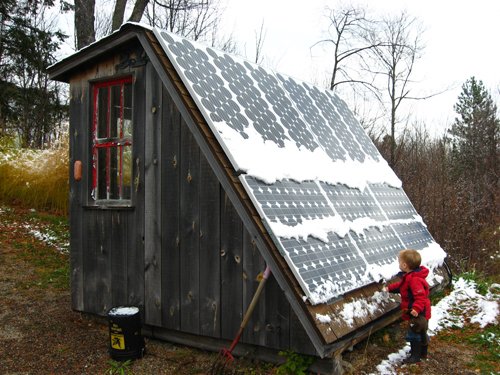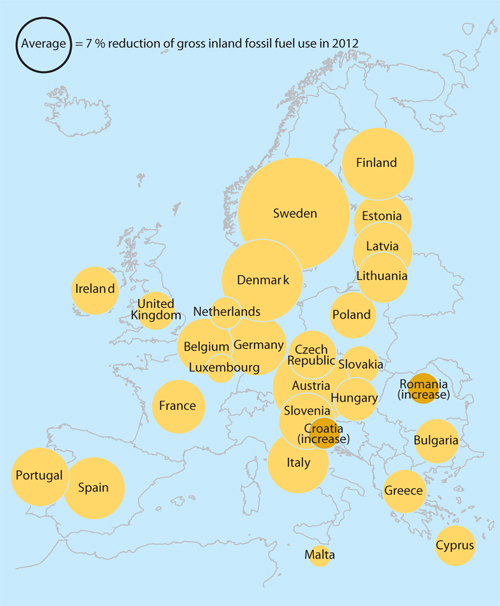 There was a slower growth of solar PV in 2013 compared to previous years. Photo: Peter Blanchard/flickr.com/CC BY
There was a slower growth of solar PV in 2013 compared to previous years. Photo: Peter Blanchard/flickr.com/CC BY
An EEA report shows modest growth in renewable energy consumption with a dominance by PV and wind in 2013. Another study claims that the integration of around 60 per cent renewables into the European electricity system could be feasible by as early as 2030.
According to the European Environmental Agency (EEA) report, the EEA data for 2013 shows that the EU-wide share of gross final renewable energy systems (RES) consumption continued to increase between 2012 and 2013, although at a more modest rate than recorded between 2011 and 2012. The EEA finds that in 2013 the share of gross final consumption of RES increased in all but one member state from 14.1 per cent in 2012 to 14.9 per cent in 2013. This progress enabled the EU to meet the 12.1 per cent indicative target for 2013–2014 in line with the Renewable Energy Directive (RED), as well as the 13.7 per cent expected EU-wide share for gross final renewable energy consumption in line with the National Renewable Energy Action Plans (NREAPs) adopted by countries.
The EEA report provides specific information at EU and national level on estimated RES progress in 2013, estimated gross avoided carbon dioxide (CO2) emissions and avoided fossil fuel use due to the additional use of renewable energy since 2005, as well as an assessment of the statistical impacts of growing RES use on primary energy consumption.
The renewable heating and cooling market sector retained its dominance in the gross final consumption of all renewables in the EU. However, the renewable electricity sector grew faster and contributed the most to absolute growth in renewables use across all EU countries. By contrast, the use of RES in transport contracted in 2013 in about half of all member states and at EU level.
In recent years, the deployment of RES has increased strongly in the EU, from an 8.7 per cent share in gross final consumption in 2005, to 14.1 per cent in 2012. In absolute terms, final renewable energy use increased by 58 million tonnes of oil equivalents (Mtoe) over this period, at an average annual growth rate of 6.4 per cent (6.6% per year if only biofuels complying with the RED sustainability criteria are taken into account). From 2011 to 2012, the EU’s RES consumption increased by 6.8 per cent, or roughly 10 Mtoe. This positive development was stimulated by national targets under the RED, the introduction of specific national support frameworks for renewables, and substantial cost reductions recorded by some modern RES technologies, especially solar PV. As such, renewables (mostly solar PV and wind) accounted in 2012 for almost 70 per cent of new electrical capacity added in Europe.
Regarding avoided fossil fuel use, EEA estimates show that the additional use of renewable energy compared to the level of RES consumption in 2005 enabled the EU to cut its demand for fossil fuels by 98 Mtoe in 2012 and by 116 Mtoe in 2013, respectively. In 2012, 12 member states saw reductions in their gross inland consumption of fossil fuels of 7 per cent or more, in response to RES increases since 2005 (Austria, Belgium, Denmark, Estonia, Germany, Finland, Italy, Latvia, Portugal, Slovenia, Spain and Sweden). The increase in renewable energy use since 2005 resulted in approximately 326 Mton of gross avoided CO2 emissions at EU level in 2012, and 388 Mton in 2013, with most of these effects relating to sectors covered under the EU’s Emissions Trading Scheme (ETS).
RES mostly substituted coal (13%), followed by natural gas (7%), while the reduction in oil and related fuels was less pronounced, largely explained by the modest share of RES use in transport.
The drop in the pace of growth in 2013 occurred against the backdrop of less renewables used in transport (RES T) across 12 member states, along with slower growth in the renewable electricity (RES E) and renewable heating and cooling (RES H/C) market sectors.
This slowdown is attributed to a slower growth of solar PV in the electricity sector, and of solid biomass in electricity and heating and cooling sectors, compared to the period 2011 to 2012.
The gross avoided CO2 emissions at EU level due to the use of renewables in 2012 were estimated at approximately 326 Mton. This includes approximately 250 Mton (77%) in sectors covered by the EU ETS, and 75 Mton (23%) attained in non-trading sectors. These gross avoided emissions correspond to roughly 7 per cent of the EU’s total GHG emissions in 2012, as shown in Figure 2.
The progress in the use of RES contributes to the overall transition to a low-carbon society by 2050 as well as to attaining the intermediate climate and energy targets for 2020 and 2030. The EU has recently adopted three new EU-wide commitments for climate and energy for the year 2030: 1) a binding minimum 40 per cent domestic reduction in GHG emissions compared to 1990 levels; 2) a binding minimum 27 per cent share of gross final renewable energy consumption; and 3) an indicative minimum 27 per cent improvement in energy efficiency. RES are among the key contributors to this transition, being able to mitigate emissions of greenhouse gases (GHGs), lower other environmental pressures associated with conventional energy production and overturn the dominance of fossil fuels.
This transition also leads to fewer environmental and health impacts; reduced reliance on fossil fuel imports; and improved competitiveness through boosting jobs, skills, innovation and green growth in the cleantech sectors of the future. The progress in the deployment of renewables during this decade has profound implications for the future path towards 2050. For 2050, EU leaders have endorsed the objective of reducing Europe’s GHG emissions by between 80 and 95 per cent below 1990 levels, in line with proposals from the European Commission.
A recent study – titled Integration of Renewable Energy in Europe – by DNV GL (commissioned by the European Commission) claims that by 2030 it could be feasible to integrate around 60 per cent renewables into the European electricity system provided that the appropriate regulatory and infrastructure support is in place. The study emphasizes the need for RES expansion to be seen in the context of the EU Energy Roadmap 2050, which for instance comprises the ‘Energy union’ and a reduction in greenhouse gas emissions.
Smart grid technologies are expected to play a pivotal role in the maturation of flexible grids due to their ability to minimize the need for distribution expansion. The report suggests that active voltage control by distribution networks and decentralized generators are both effective and feasible, and that the best way to handle solar and wind integration into the grid is to create a balanced geographical distribution, which would entail taking solar and wind capacities away from the best resource location and moving them closer to load centres, with cost-saving potential. In addition to wider application of technical measures, it also calls for extended use of market-based instruments, such as incentivizing the parallel expansion of renewable generation and network infrastructures, promoting a balanced distribution of decentralized generation, and promoting the development and use of innovative technologies.
Miriam Markus-Johansson
Source: Renewable energy in Europe — approximated recent growth and knock-on effects, EEA Technical report No 1/2015
Integration of Renewable Energy in Europe, DNV GL
 Figure 1. Shares in gross inland energy consumption (EU-28, 2012) Source: Eurostat, 2014b
Figure 1. Shares in gross inland energy consumption (EU-28, 2012) Source: Eurostat, 2014b
 Figure 2. Gross avoided emissions compared to total emissions (%), 2012
Figure 2. Gross avoided emissions compared to total emissions (%), 2012















